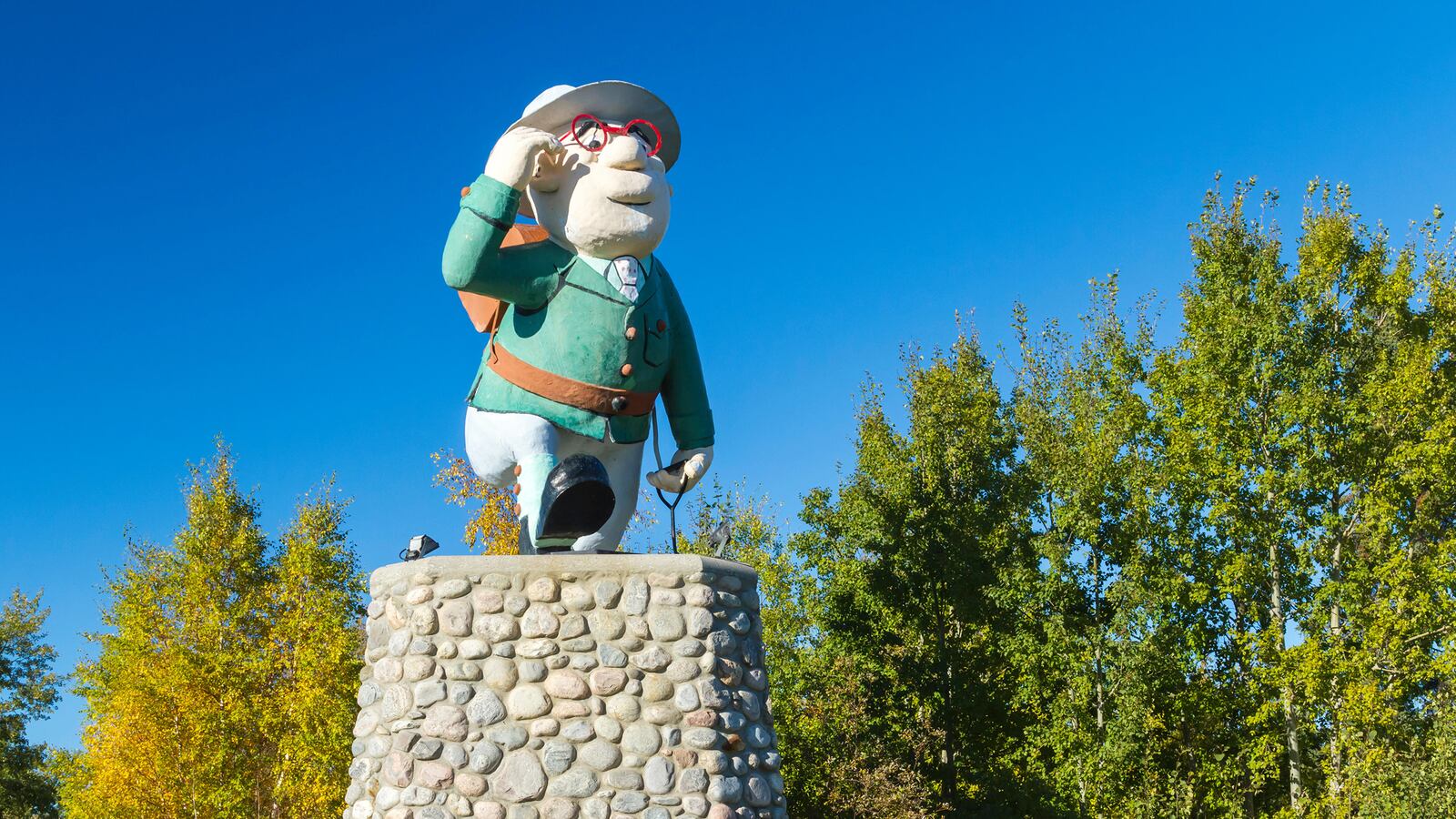A town by any other name might just be your typical company mining town in the remote reaches of Manitoba, Canada. But not so for the sci-fi-loving, marijuana-growing, NHL-player-breeding hamlet of Flin Flon.
The town’s minuscule yet eccentric population of 5,500 strives hard to make Flin Flon live up to its unusual name.
The tale of Flin Flon begins in 1915, when a mining prospector was scouting the Manitoba area.
He found a dime novel in a nearby cabin, read it, and passed it around among his fellow prospectors.
The book was The Sunless City, a science fiction tale of an eccentric prospector named Josiah Flintabbatey Flonatin who takes his submarine to the bottom of a lake and happens upon a city of gold run by women.
Not long after, they hit upon the mineral deposits that would define the community.
Legend has it, when the prospector discovered his first hole, he proclaimed, “Boys, I guess we’ve found old Flin Flon’s mine.”
Soon, thousands of miners turned up to Flin Flon in search of work in the mines, and the town blossomed.
Today, a statue of the town’s namesake designed by cartoonist Al Capp greets visitors to Flin Flon and another statue, of Flonatin in a submarine, is in the town center.
Dennis Ballard moved to Flin Flon as a 13-year-old. He tried to leave, going away for school and teaching for a year, until he found himself drawn back to his hometown.
He served as a school headmaster and then spent two terms as mayor until retiring in 2006.
“I wanted to give back to the community and make changes, but if you dig down into a politician you’re going to find one hell of an ego,” he says.
The 74-year-old’s changes put little Flin Flon on the map.
In 2001, under Ballard's reign, Flin Flon became home to what was soon known as the “ganja mine.”
A company called Prairie Plant Systems had won the government’s first medical marijuana contract: a $5.7 million agreement to grow more than 4,000 pounds of the plant. And it decided to use an abandoned section of a zinc mine in Flin Flon for the groundbreaking experiment.
The growing facility was buried more than 1,000 feet underground with a 12,000-square-foot chamber.
First, the company tested the environment by planting tomatoes and roses. Then, it turned to marijuana. Before long, Flin Flon was known world-wide for its green habit.
“Let me tell you, it caused a stir,” says Ballard. “Reporters from New York and all over the place were here.”
Ballard had his hands full as mayor, but that didn’t stop him from attempting to take on another role.
“I applied for a job as a tester but they wouldn’t let me. You know, quality control,” he says laughing. “I could’ve been like Rob Ford, eh?” he adds, naming Toronto’s notorious crack-smoking mayor.
But the mine operations were airtight—not even the names of its employees were disclosed for security reasons. Ballard never even got a peek inside. “The security there was better than Fort Knox,” he says.
In 2009, the mine owners declined to offer Prairie Plant Systems a new lease and the company announced it would move its marijuana operation to a new and undisclosed location.
The operation had promised to bring 200 jobs to the town, but had just 12 full-time workers at the time it closed.
Two years later, after three decades and 24 million tons of ore produced, the entire mine shut down.
Even before its now-notorious marijuana crop, Flin Flon had a secret talent.
“Have you heard of the Flin Flon Bombers?” Ballard asks, surprised when I say I haven’t. “That’s kind of a known thing. When you go somewhere and say you’re from Flin Flon the first thing people say is, ‘That’s a weird name.’ Then they say, ‘The Flin Flon Bombers.’”
The town is famed across Canada for the skilled hockey players it churns out via its 88-year-old junior league team.
At least 17 Flin Flon players have made it to the National Hockey League, including Hall of Fame player Bobby Clarke.
“It’s the isolation again,” Ballard says of the reason such a small town has such a high ratio of pros. “What do you do?”
Perhaps, the Flin Flonners’ hard-scrabble upbringing makes them predisposed to the sport. Ballard describes his fellow townspeople as “a bit wild and unruly” and without “the same inhibitions” as others.
This all comes to a head every few years, when the town hold reunions for Flin Flonners who struck out across the globe. No matter where they settle, the Flin Flon identity remains.
“There’s an old saying,” Ballard says. “‘Once a Flin Flonner, always a Flin Flonner.’”
One year, 5,000 people showed up from out of town, nearly doubling the population.
“I’ll be damned if we can figure out where we put them all,” he says. The people who turned up had come from as far as Hong Kong and New Zealand.
“All I can say is the Flin Flonners are a special breed. I’m sure I’m a bit prejudiced. But you can almost spot them.”
Overseas, this has had destructive results. According to The Maclean’s Book of Lists, in 1943, Flin Flon servicemen stationed in London threw a reunion in Trafalgar Square that stretched through the day and ended only when the bar’s entire supply of alcohol had been depleted.
Like all mining towns, Flin Flon’s future is an uncertain one. Ballard says the town has evolved into a cultural hub of the Manitoba region. Its choir, he notes, is gearing up for its second performance at Carnegie Hall.
There’s still one major mine in operation, which, along with the processing plants, is the main employer. But for how long, there’s no telling.
“It will have a mine life,” Ballard says of the finite amount of time a mine can operate. “What happens after? Who the hell knows. You go through your whole life like that. Get used to it.”






